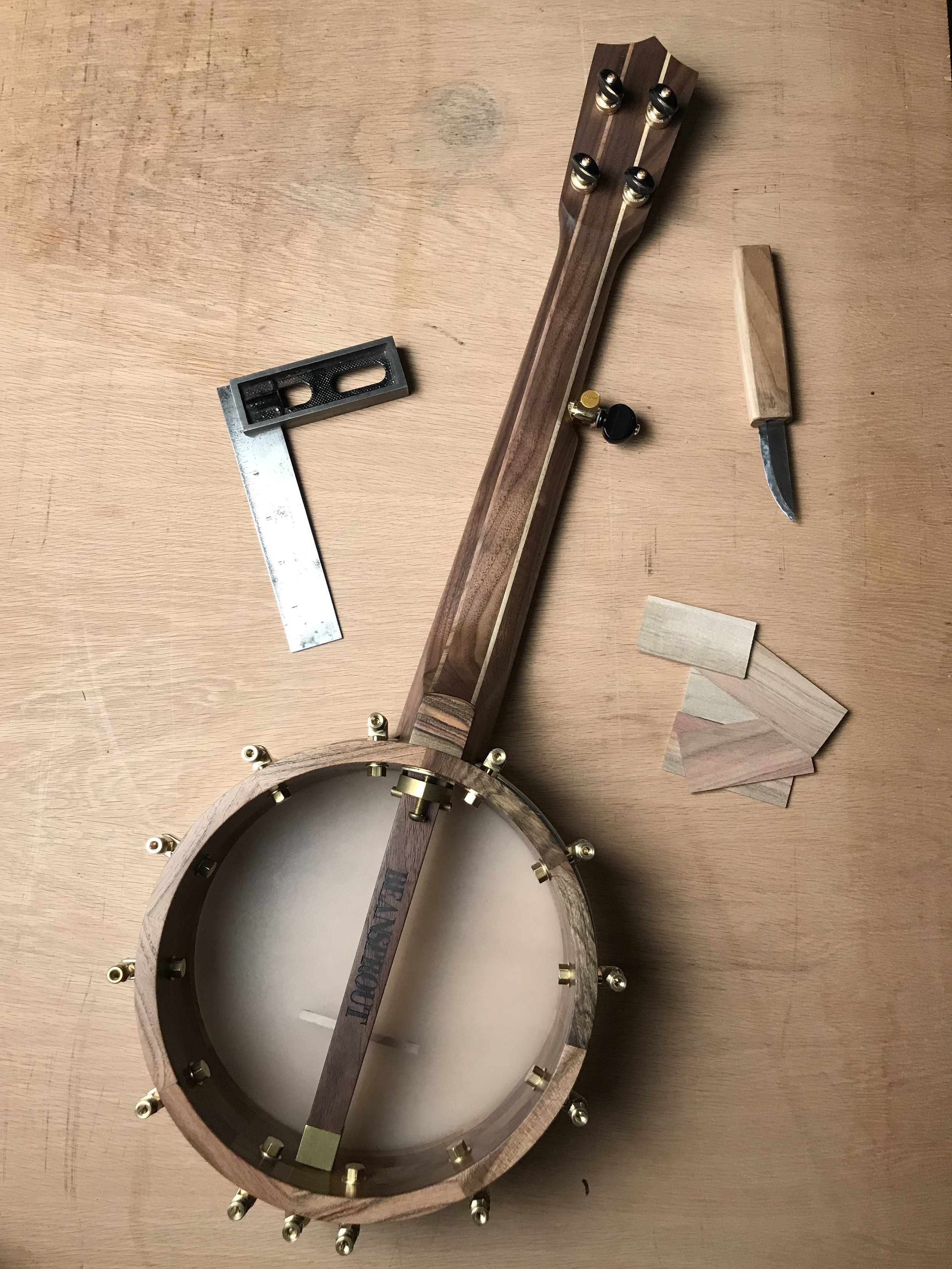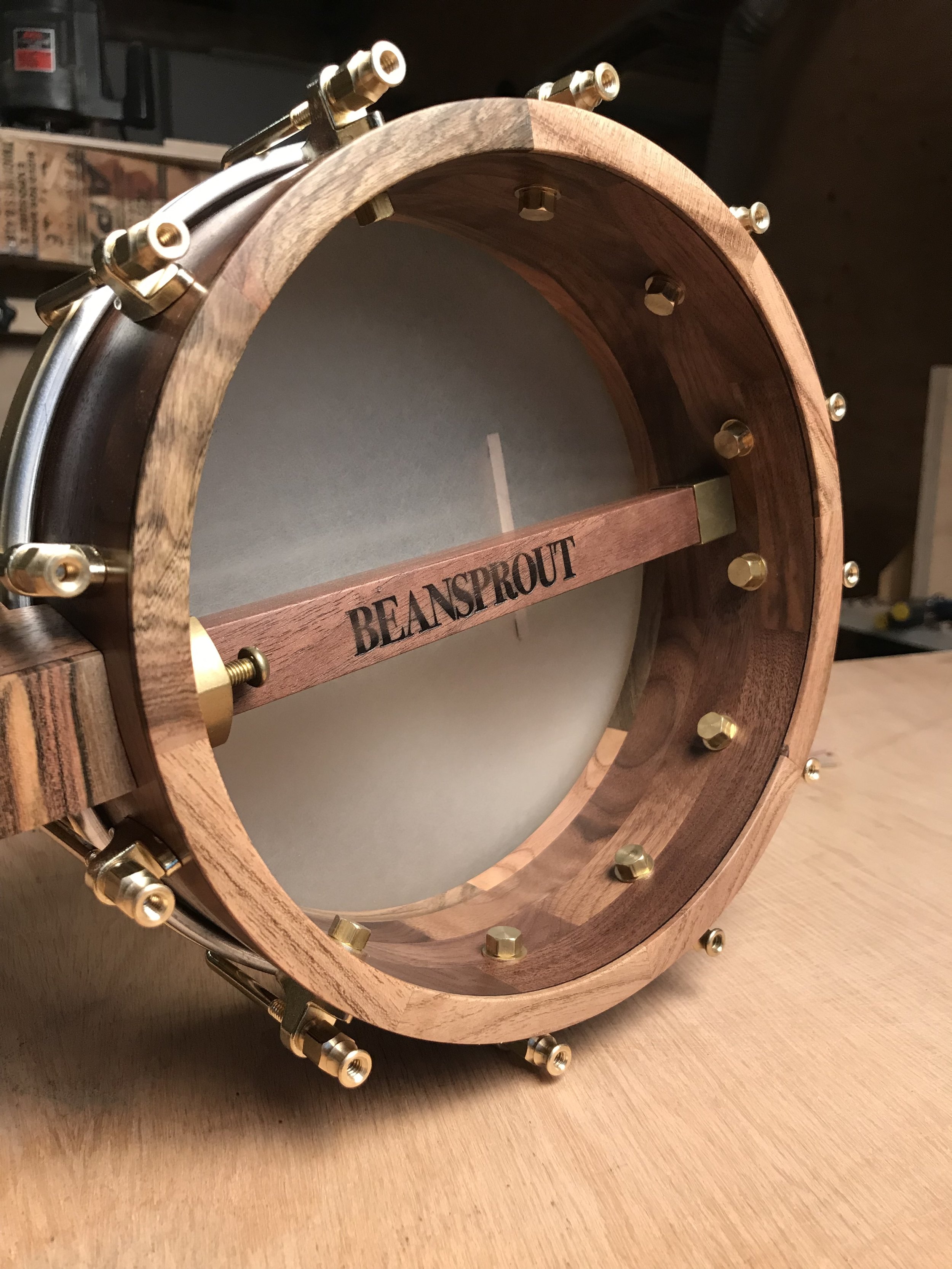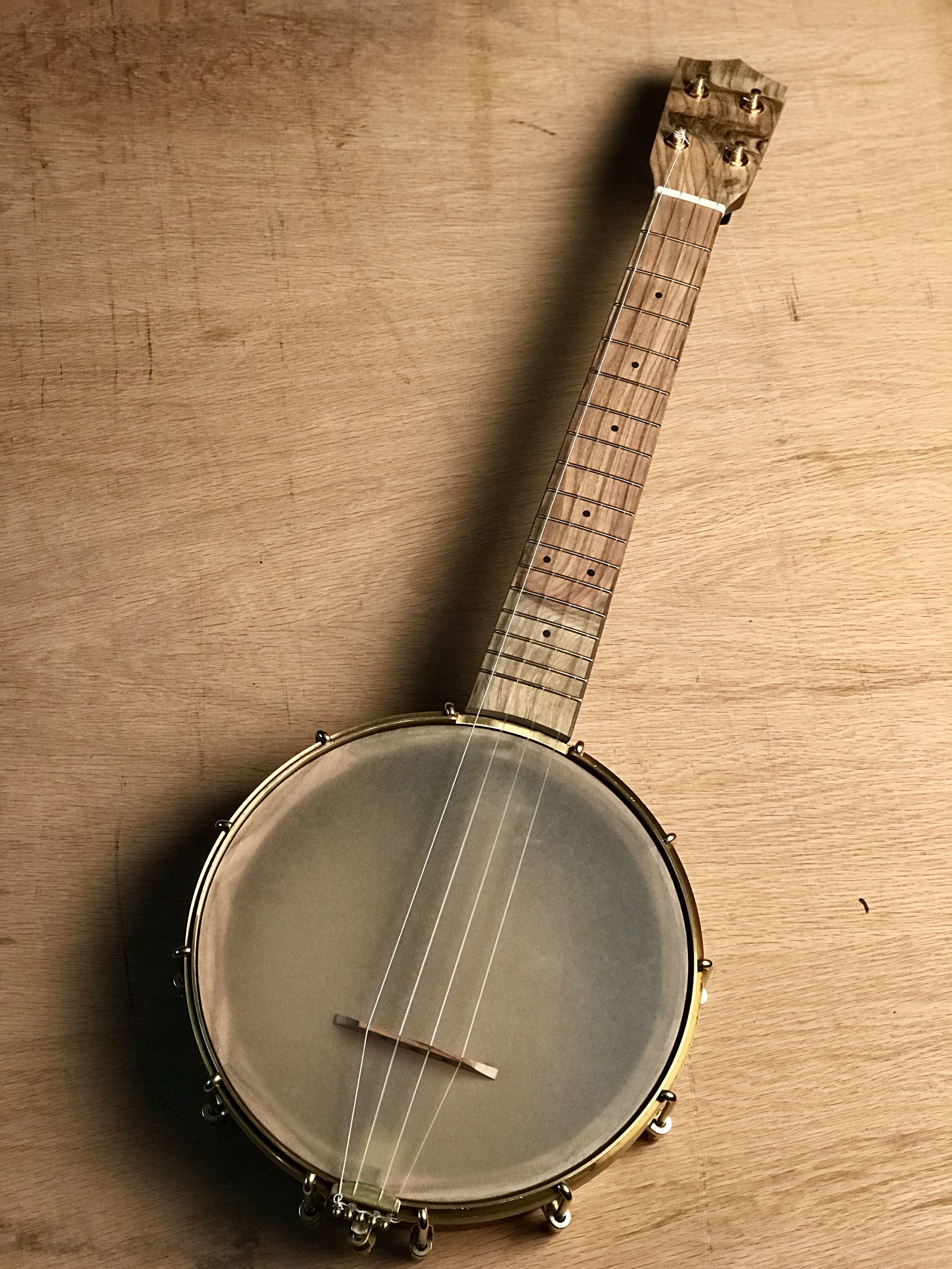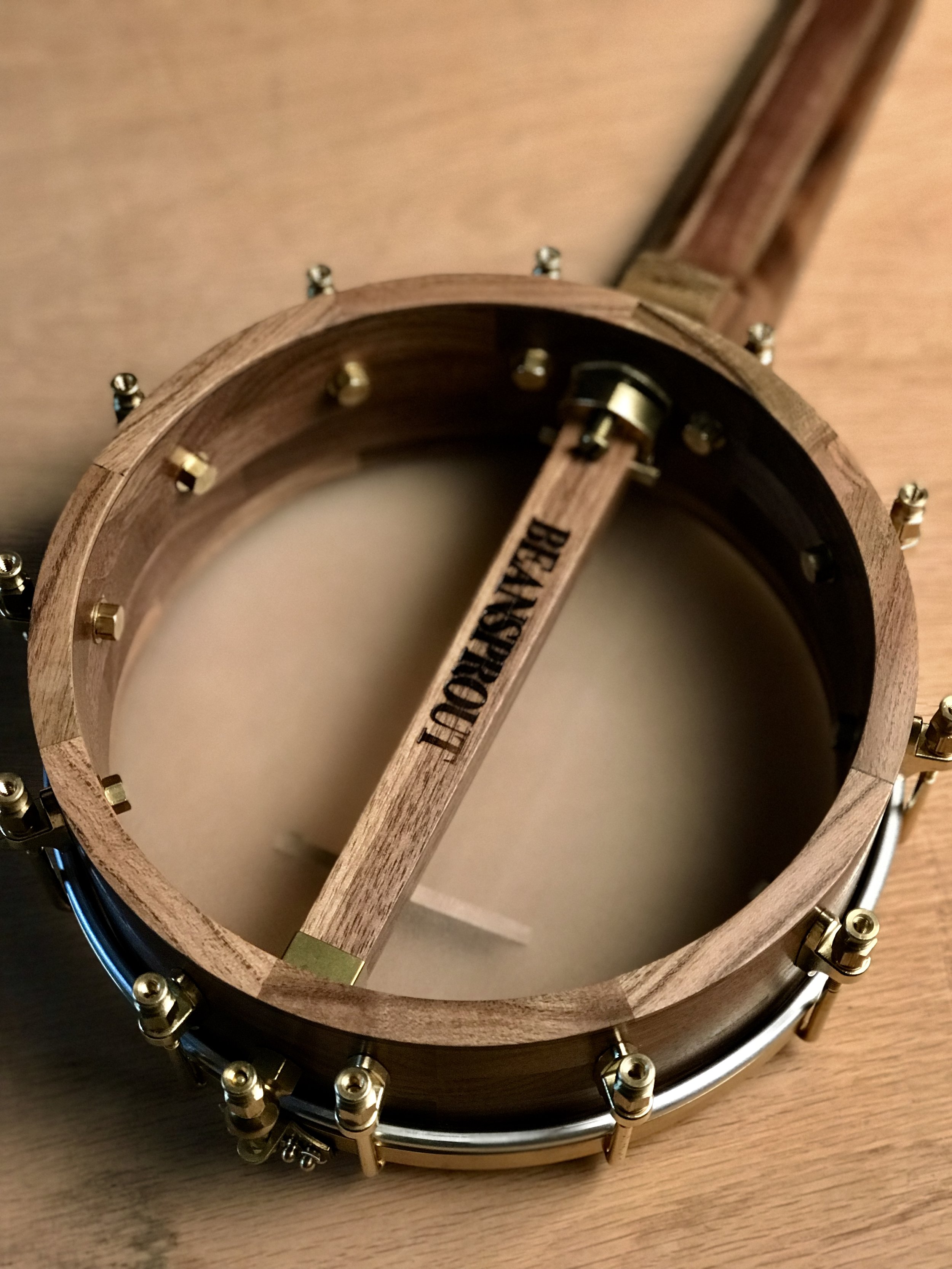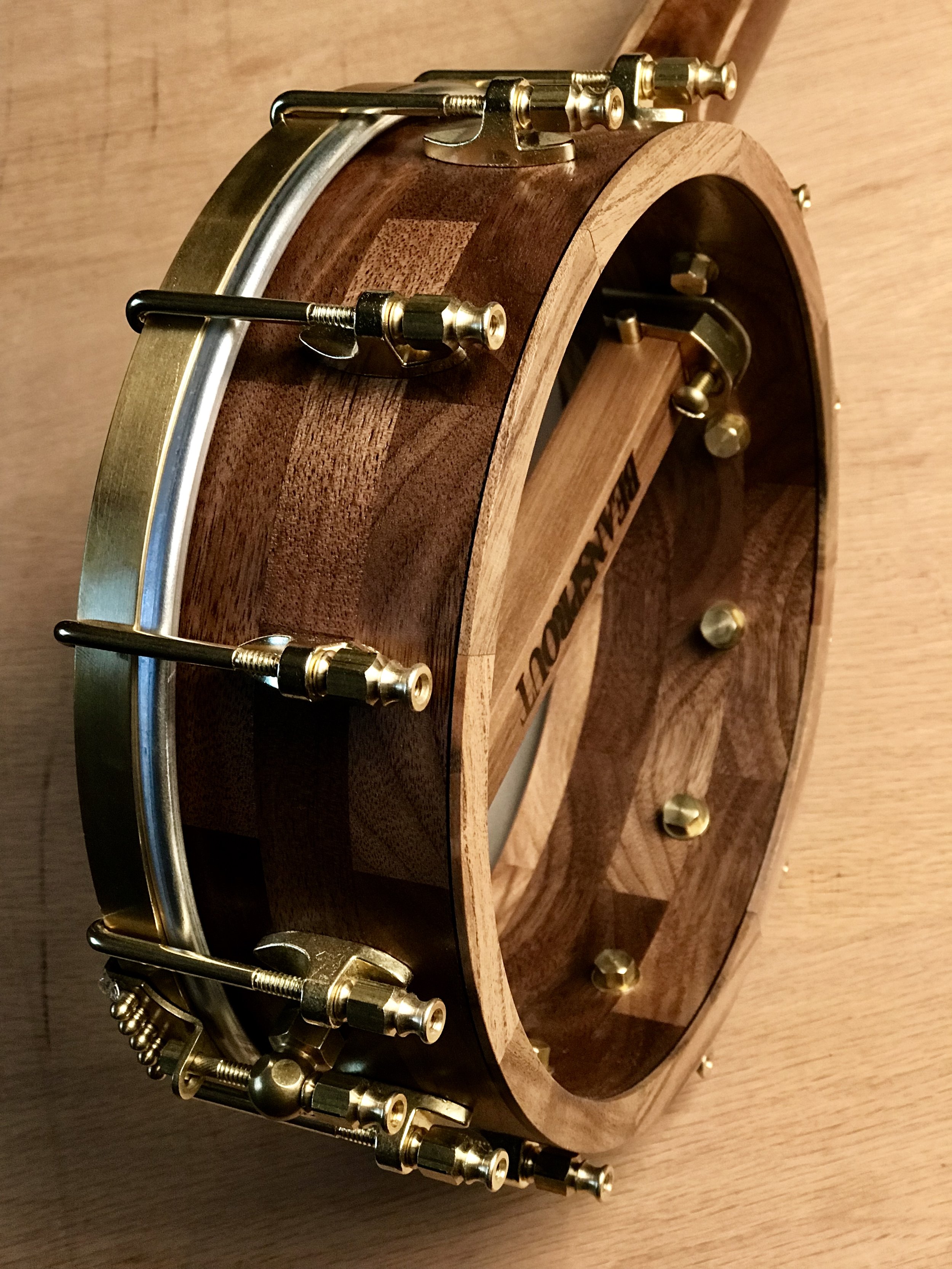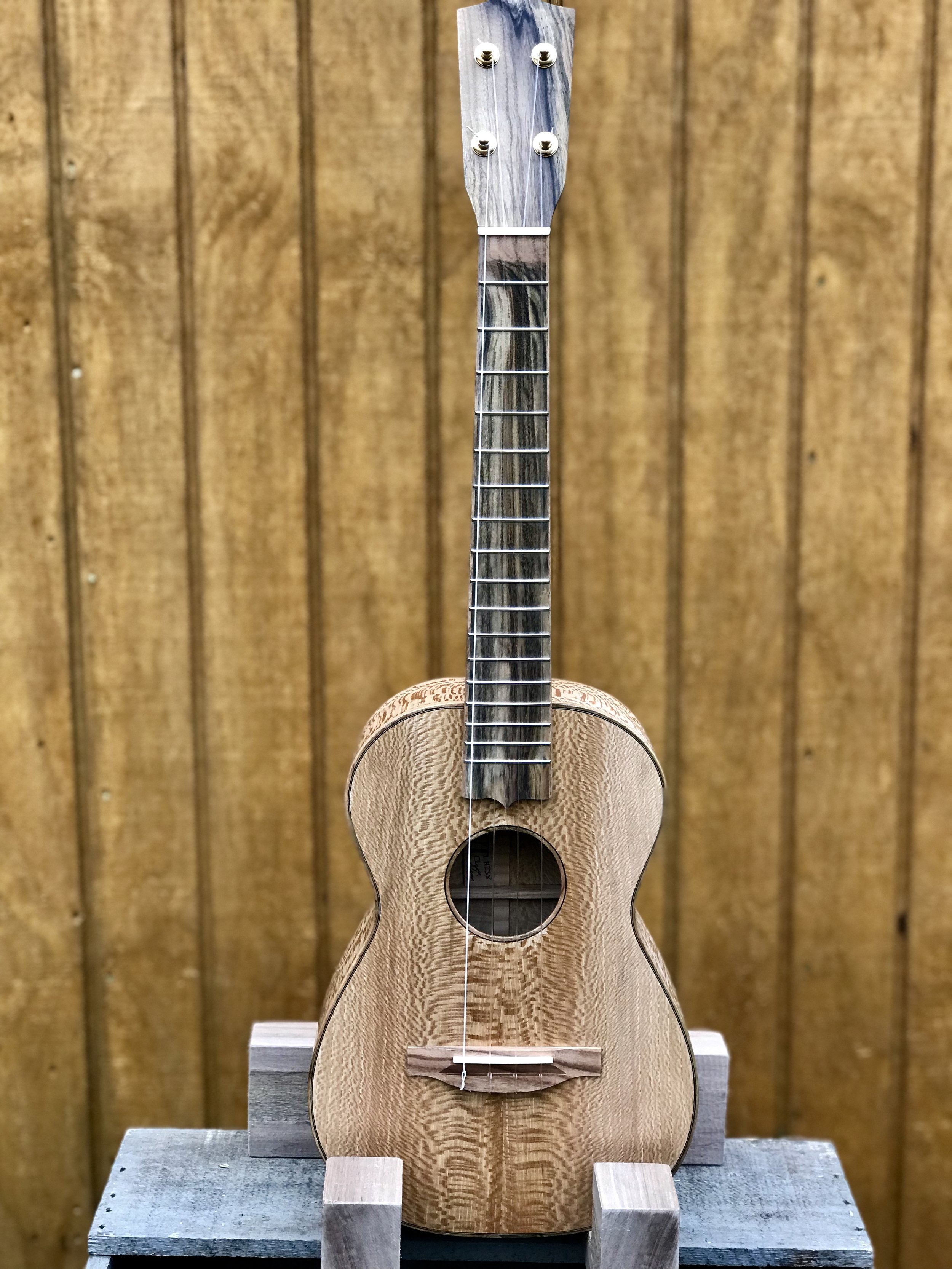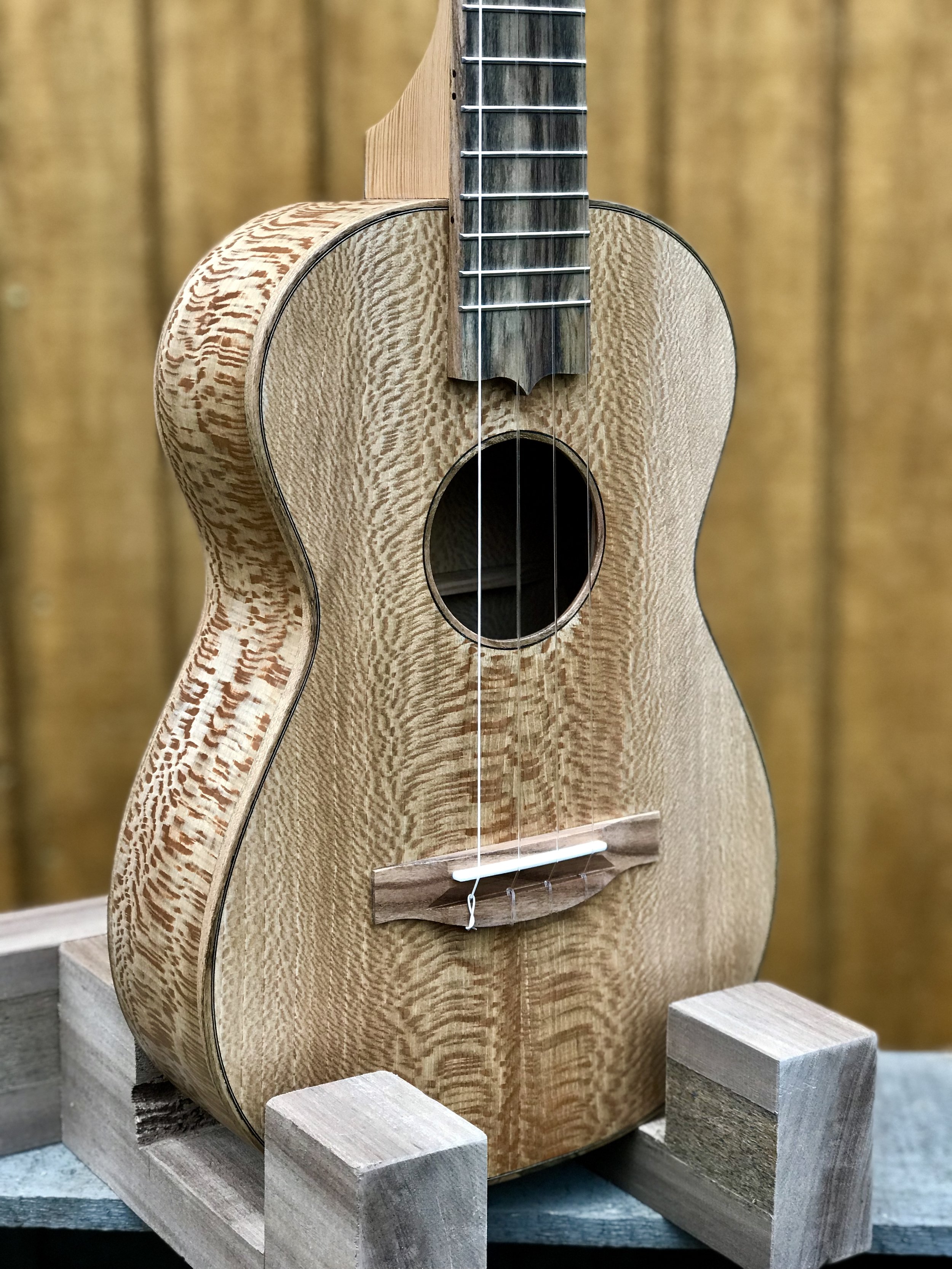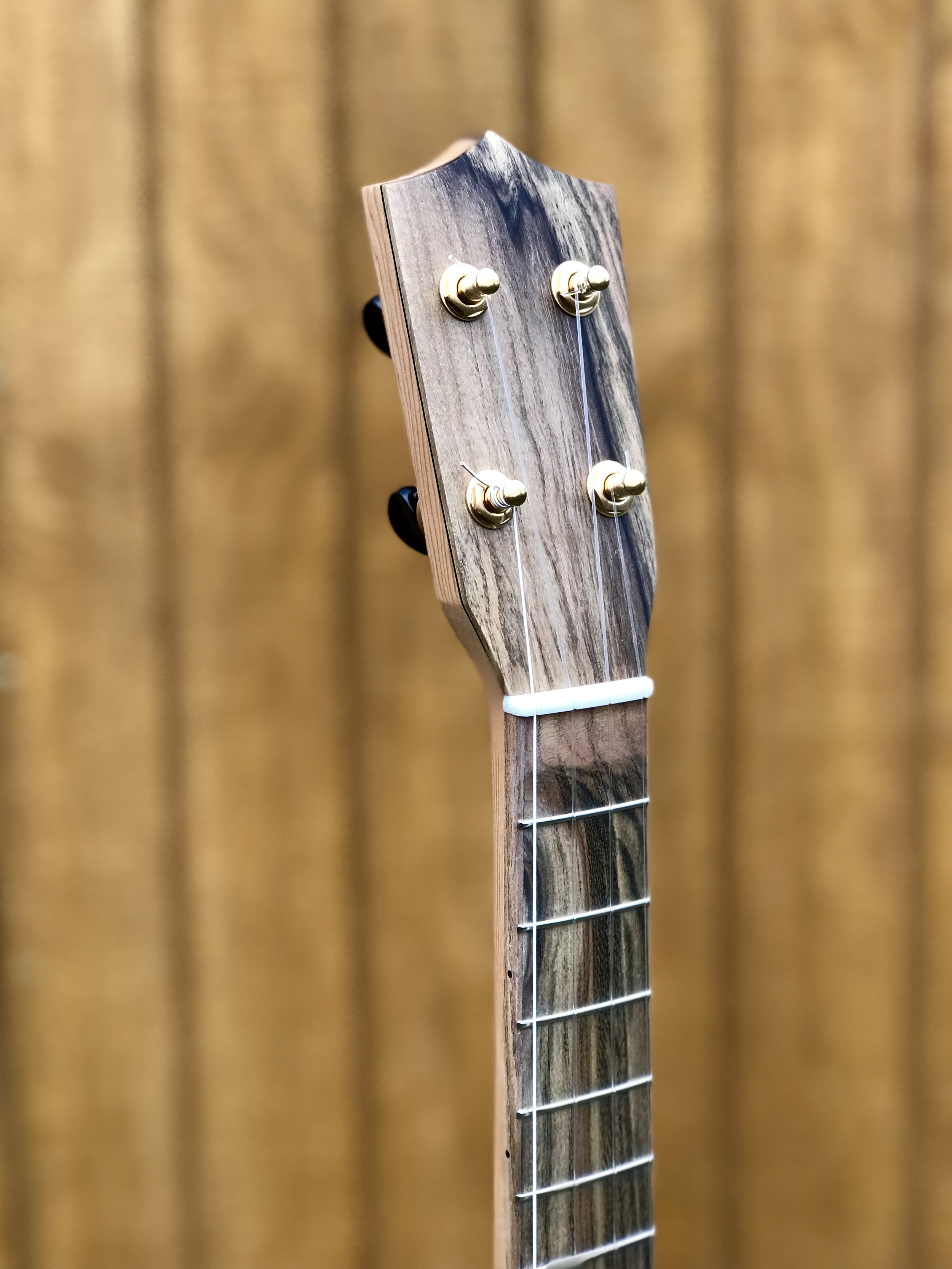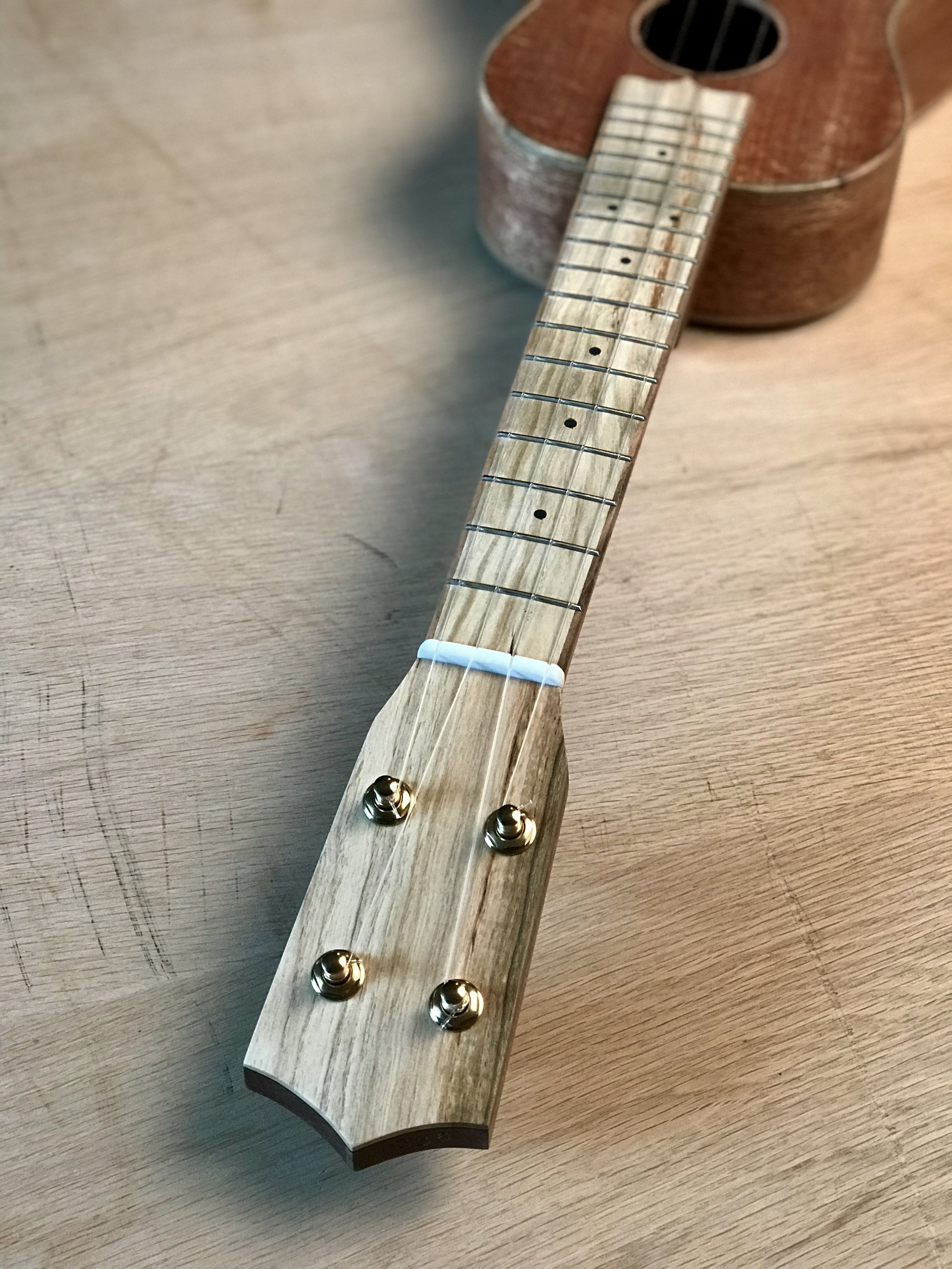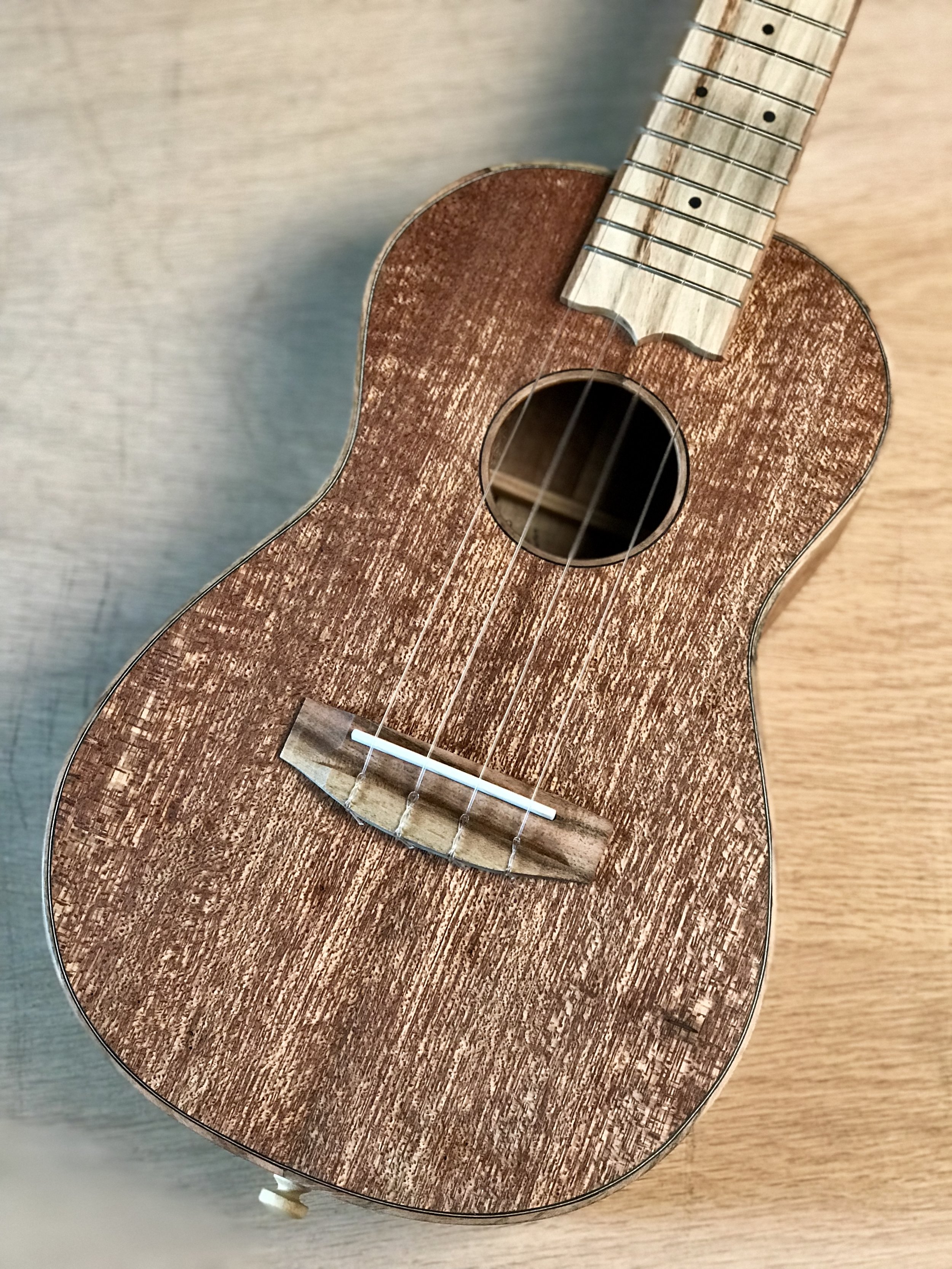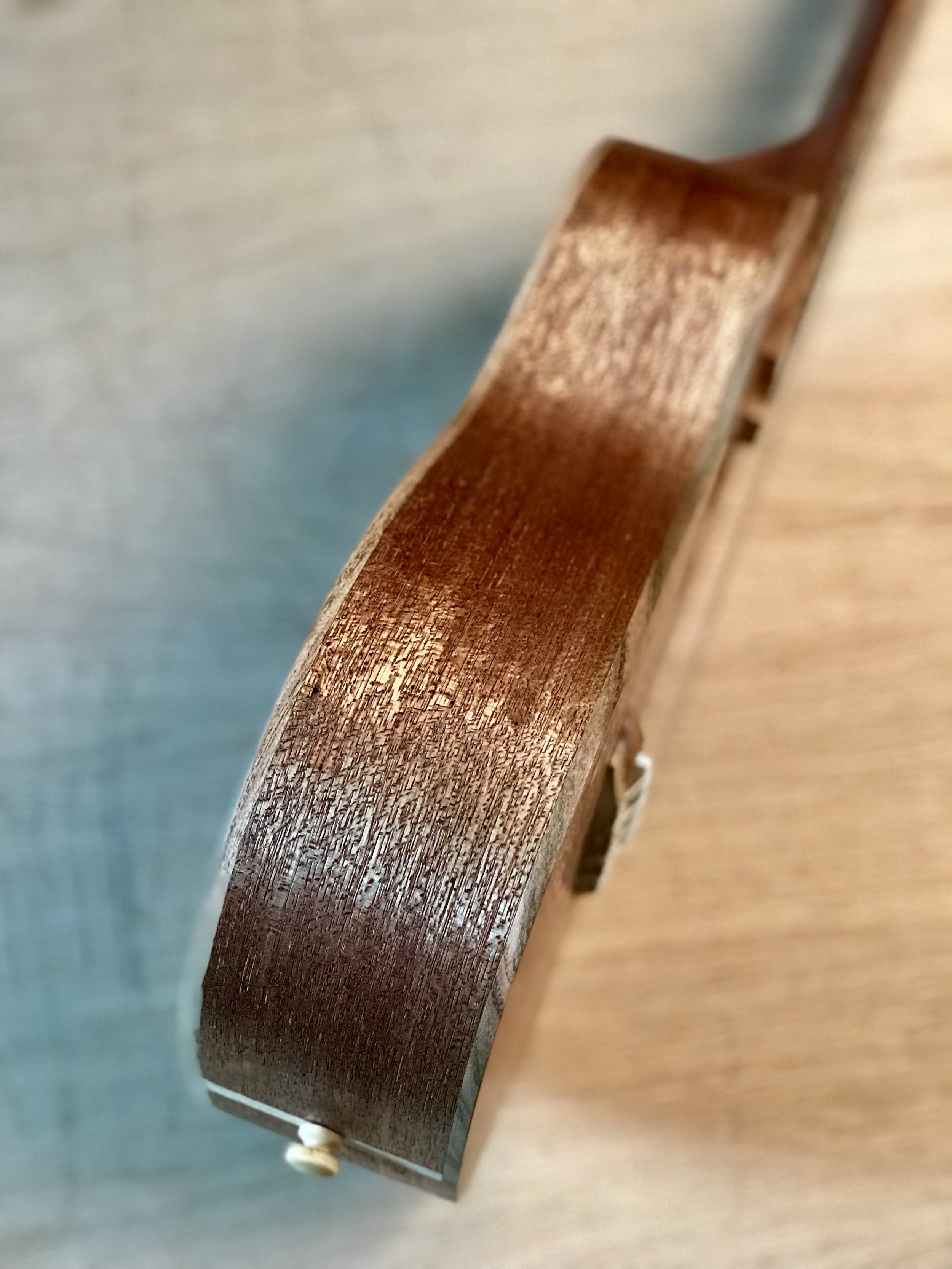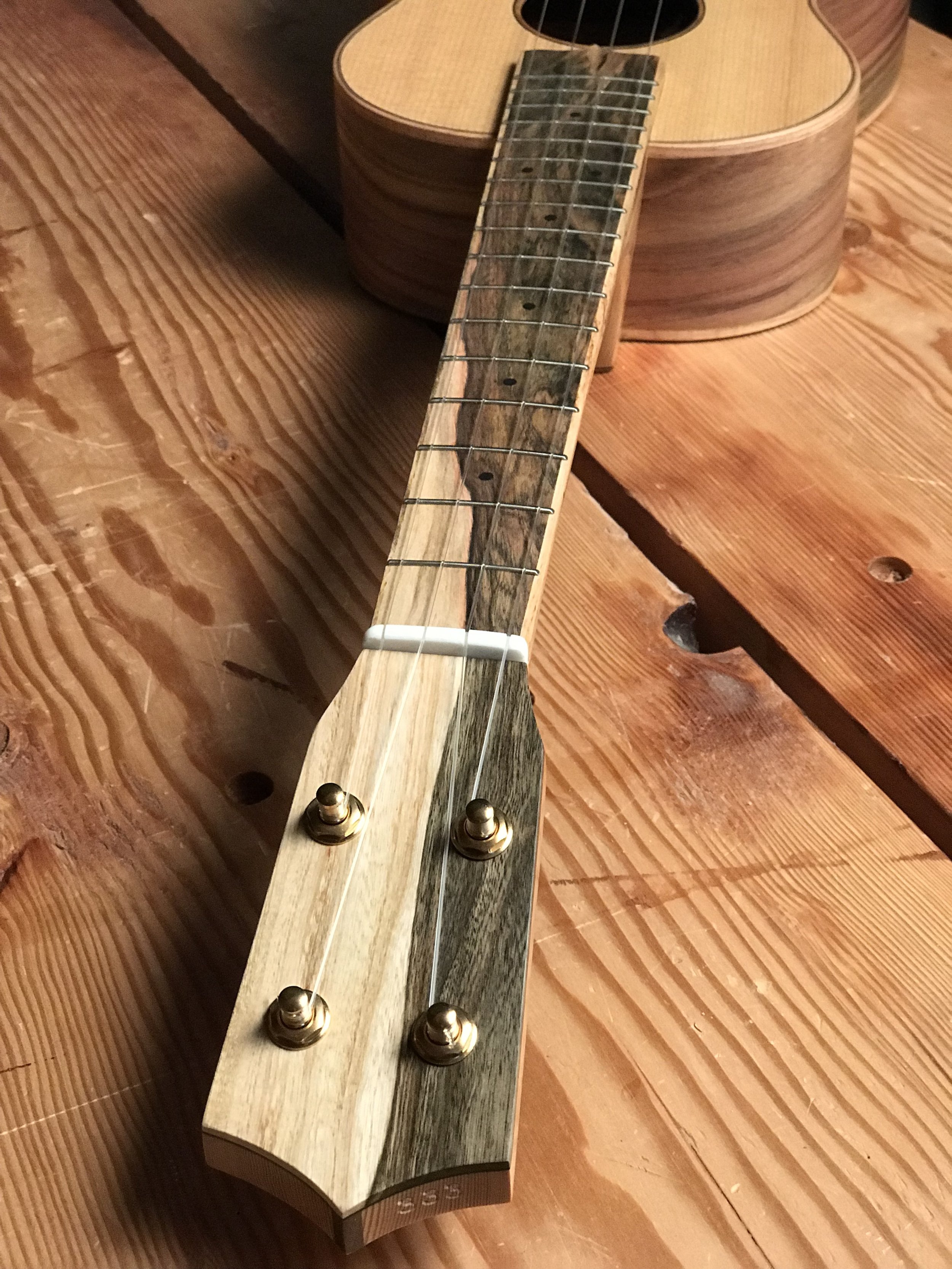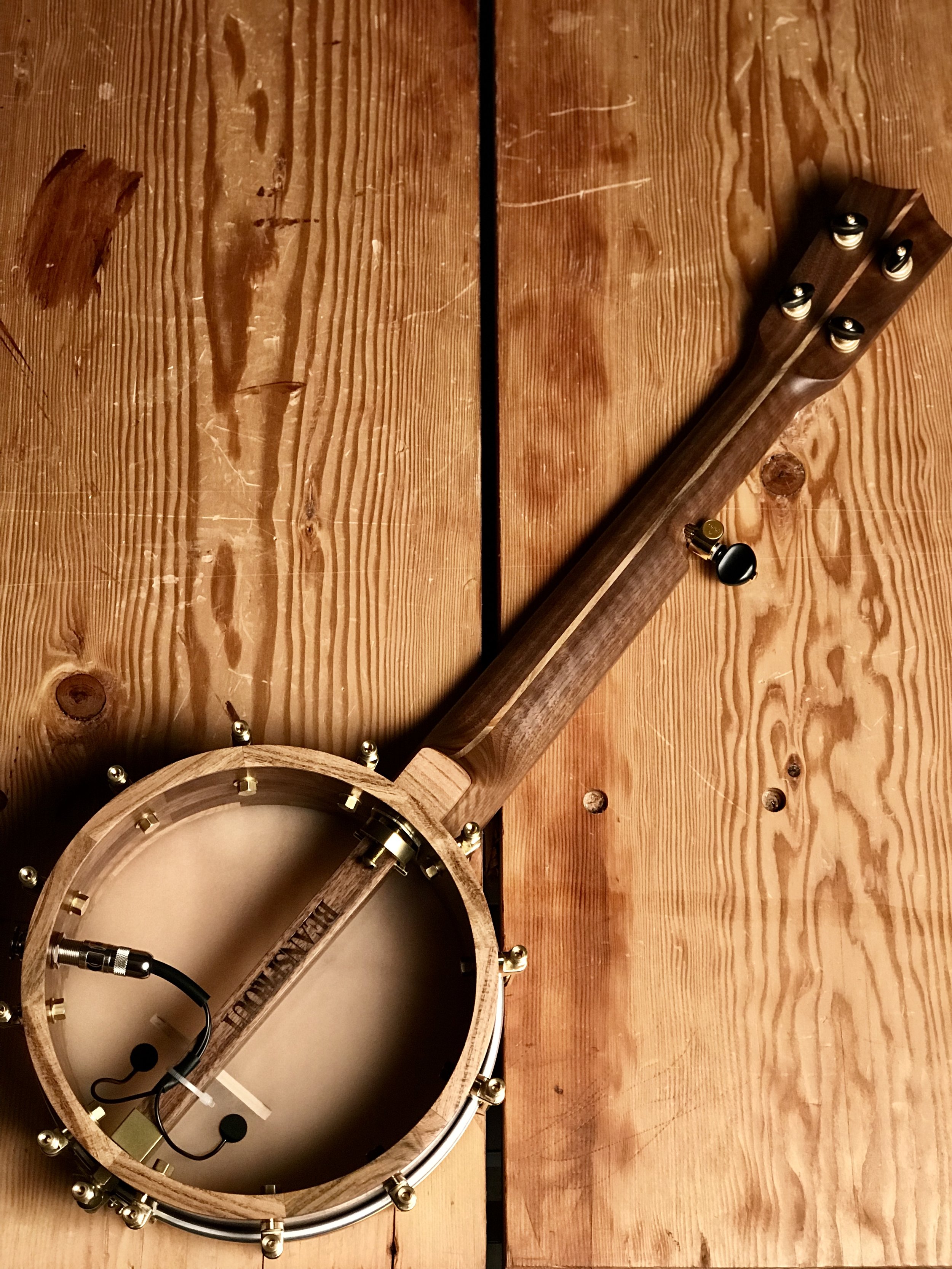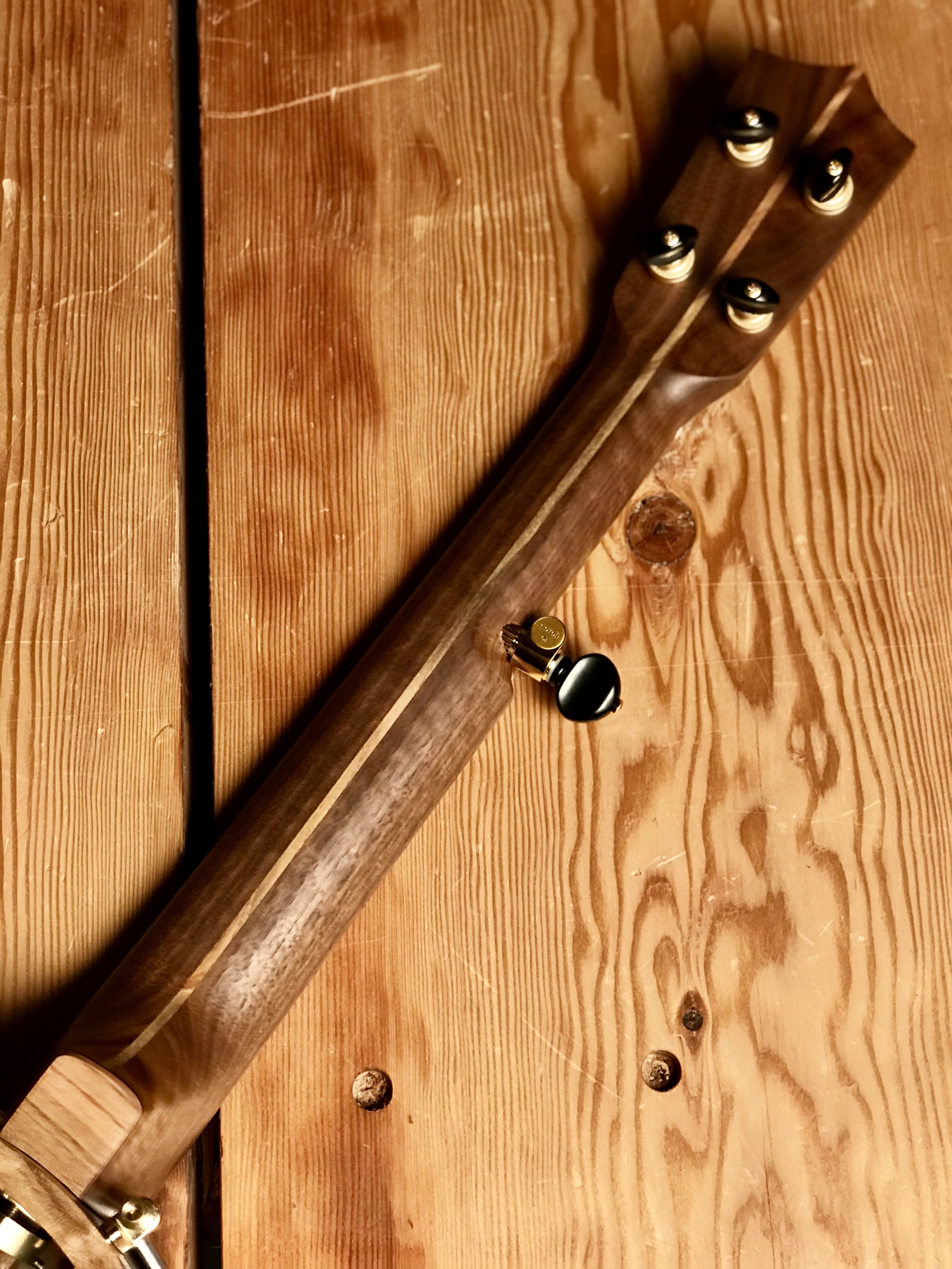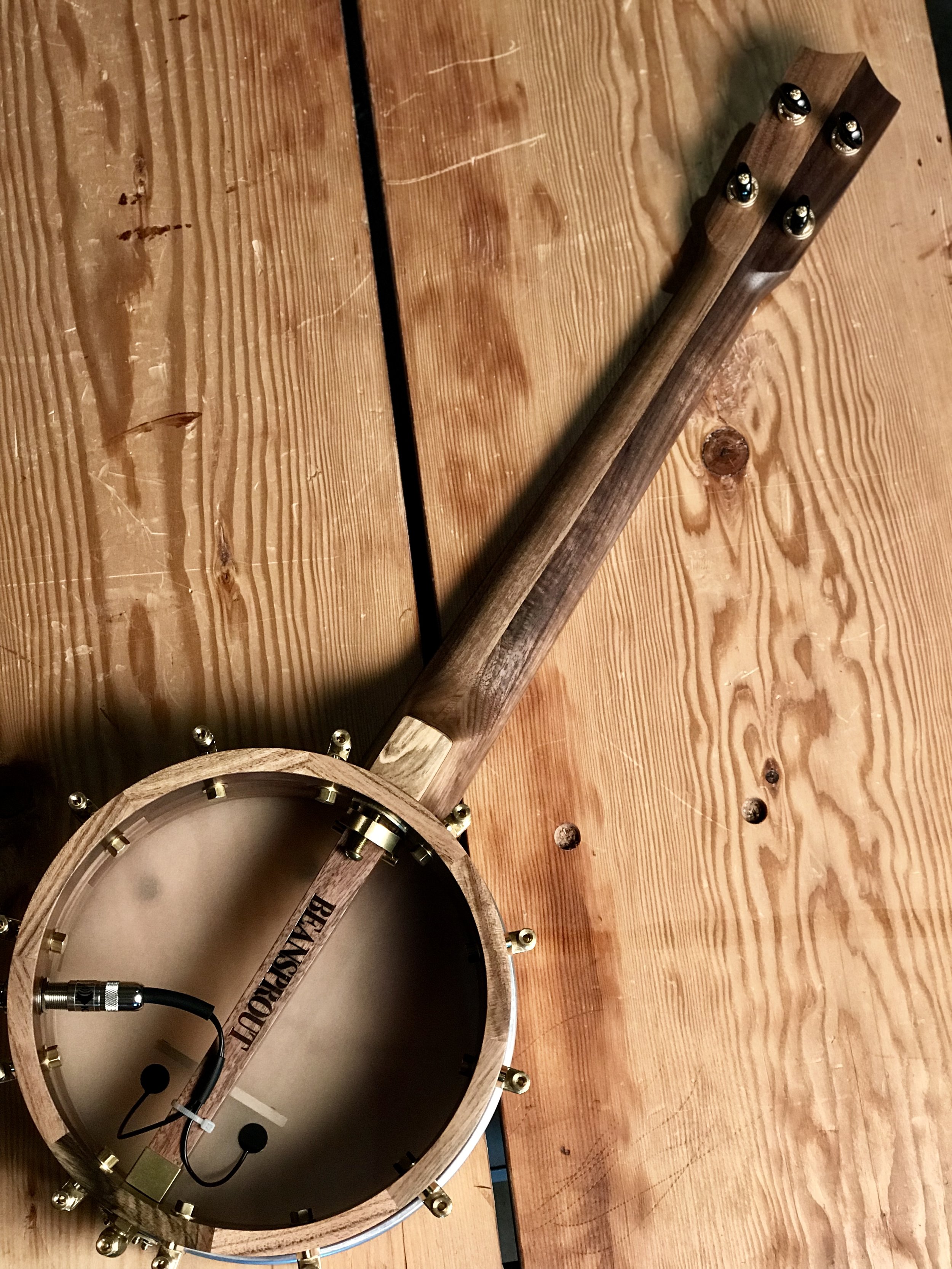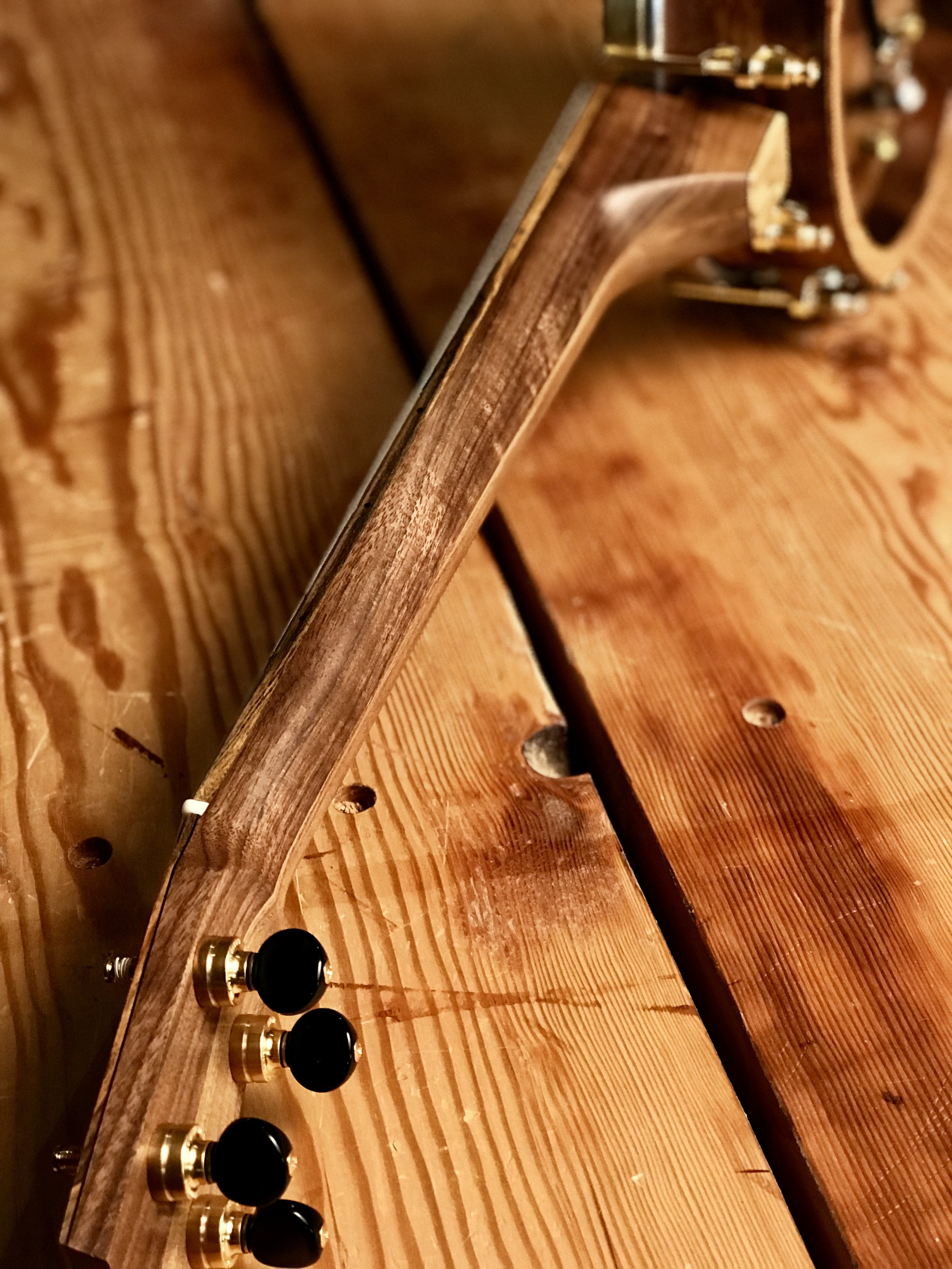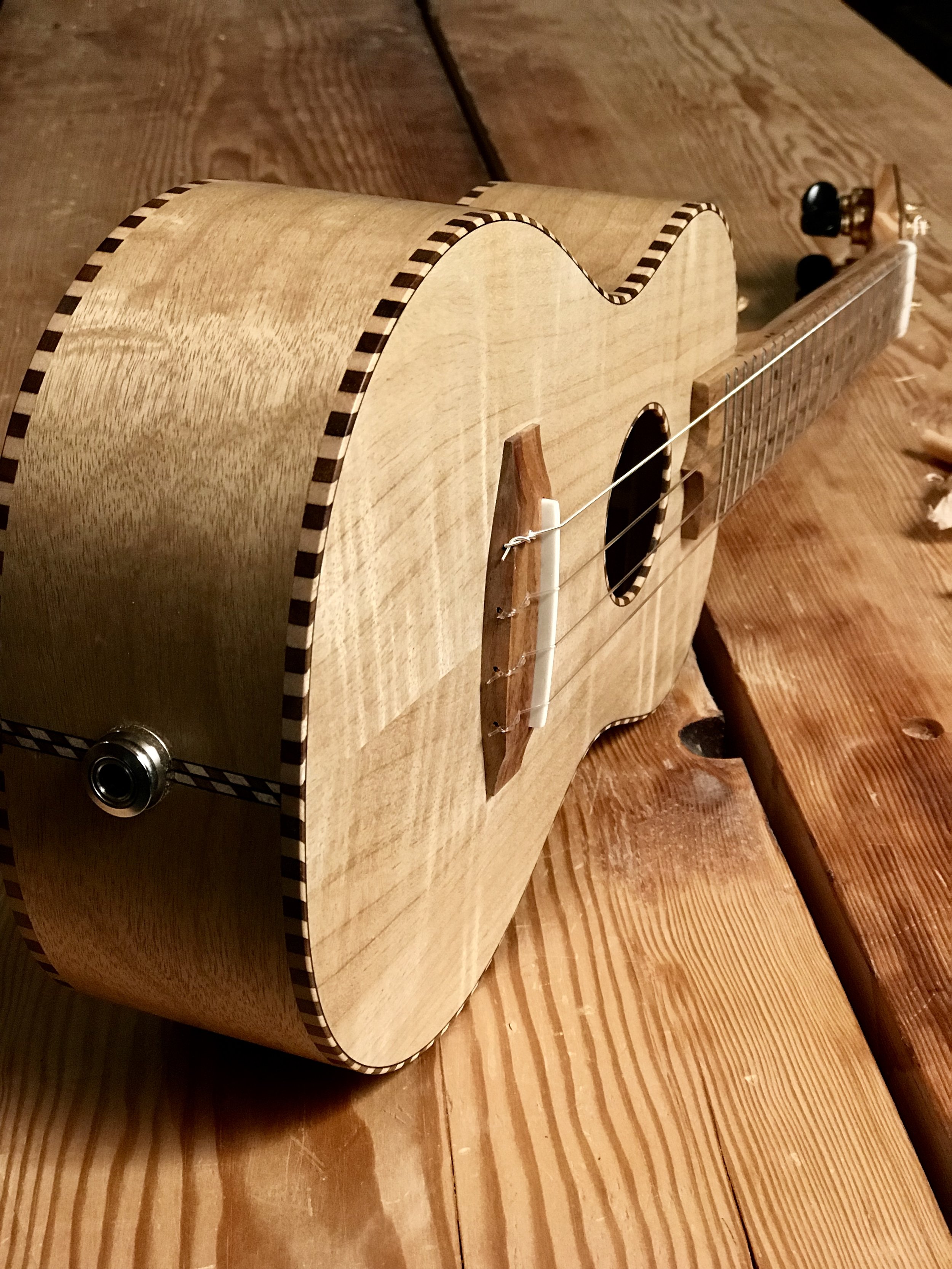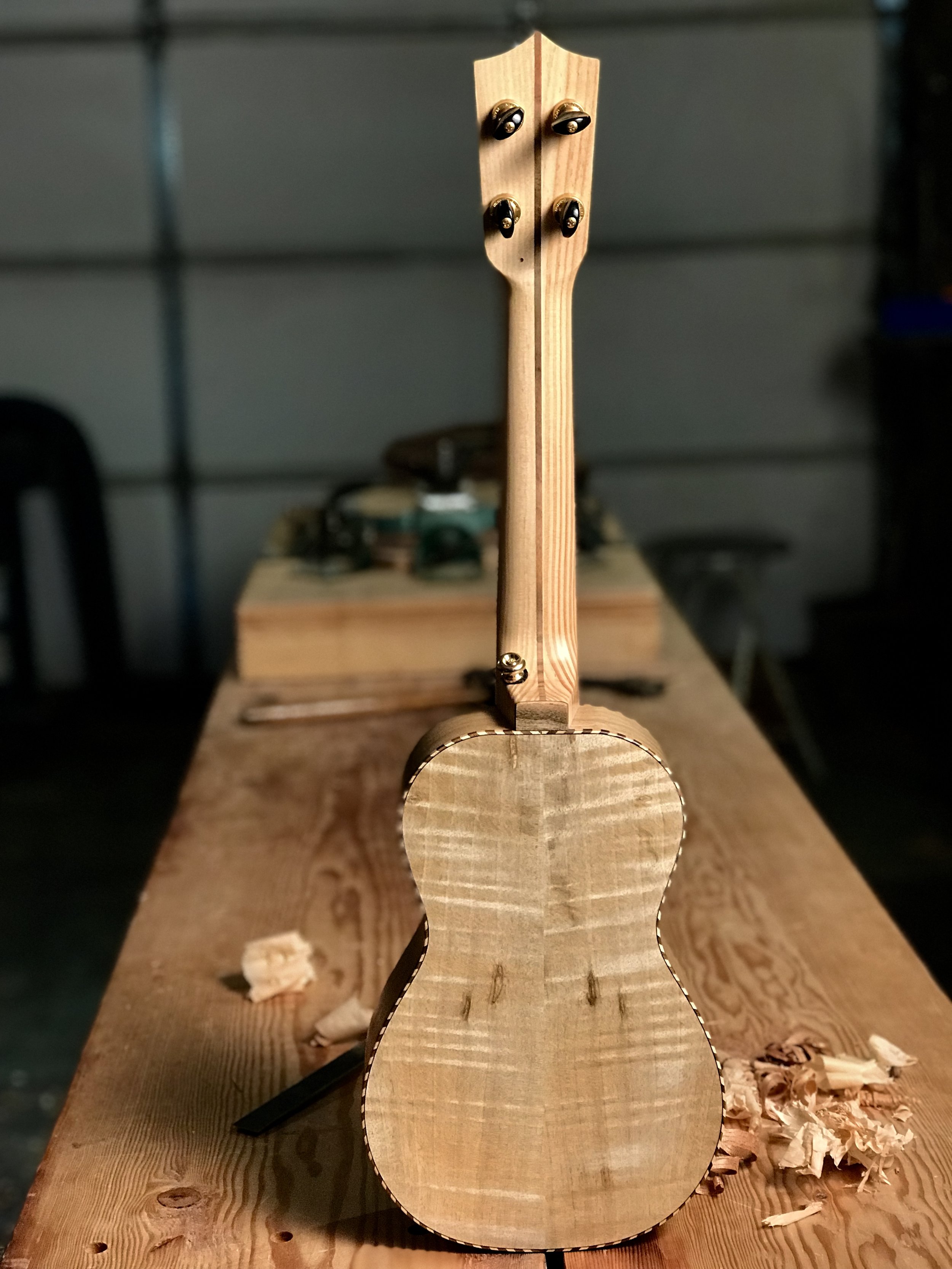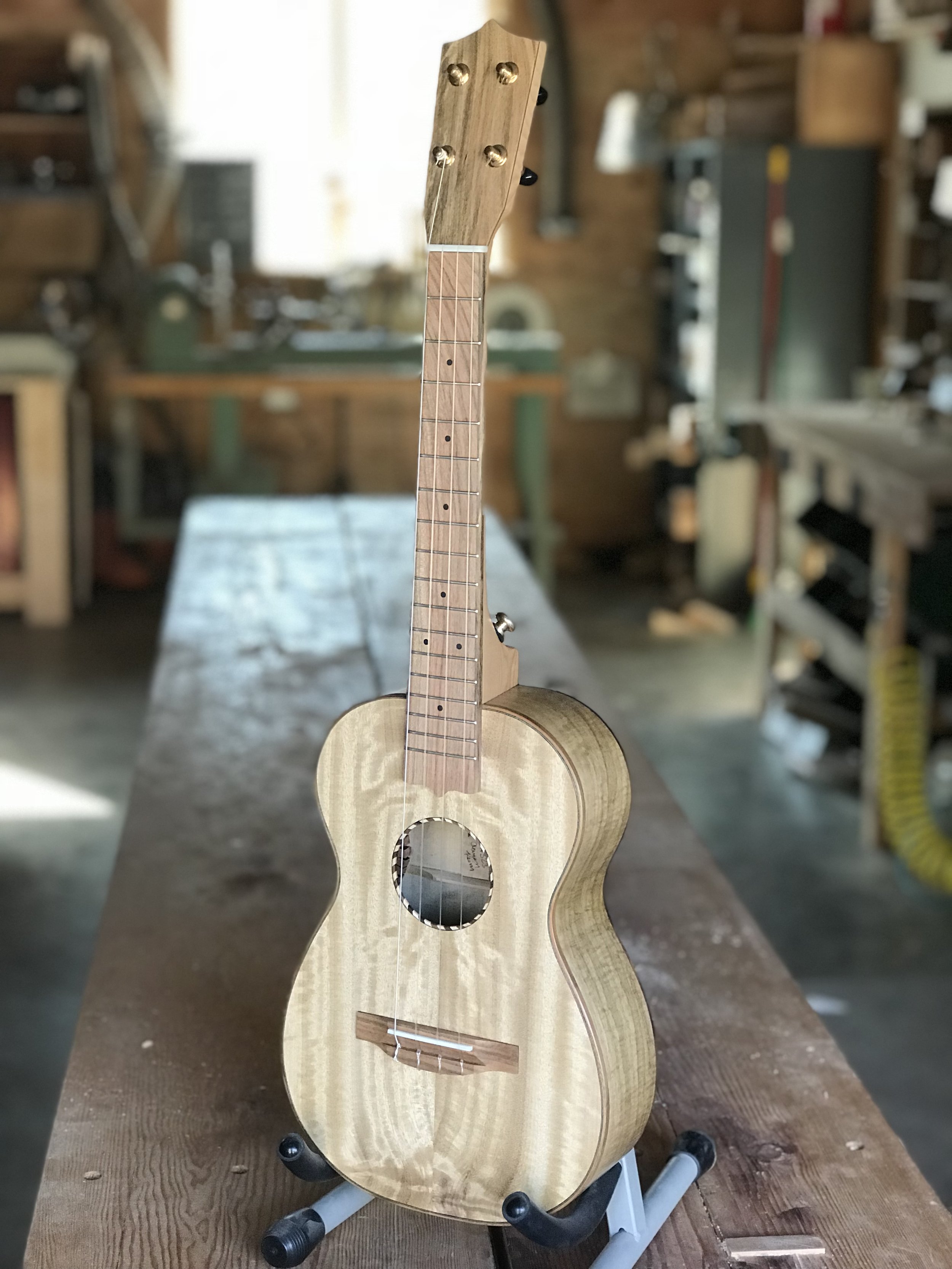This banjo is a great example of our little global business and musical culture. To begin with, it is for a customer who lives a few hours away from us but we met in Alabama at a music camp. She used to live in Hawaii and we considered grabbing some Koa from her property for the instrument before choosing Oregon walnut and California pistachio instead. The banjo is an American instrument with clear origins in West Africa. This mini version is scaled down to ukulele size, an instrument that started in Portugal and flourished in Hawaii. It was made by a guy from Wisconsin who lives in Oregon and plays Appalachian music on Hawaiian and African instruments. That is one good thing about music and musicians, we like jumping over walls better than building them.
#339- Curly Port Orford Cedar and Pistachio Tenor Ukulele
It’s the end of 2018 and this is the last instrument to ship. Even after 10 years doing this, I still need to re-learn the lessons of my past over and over again as I progress. In education, we call this a spiral curriculum; revisiting a concept repeatedly but addressing it with new wisdom each time. In this case, the customer picked out his pistachio and cedar from woodfromthewest.com. I had a catastrophic accident when routing for binding that destroyed the back. You would think by now that this wouldn’t happen to me, but sometimes wood has a mind of its own and it doesn’t get along with rhe router. I had to scramble to pick a new back for the customer and get back on track. I heard Gordon in my head with a common lesson from my early days: “it’s better to do it right first than have to back up and do it twice.” Regardless, it was time to double down and deliver my best work, no matter what happened along the way.
In the end, I am pleased to deliver a tenor uke with good volume, rich tonality and a unique look. Made from materials I believe in with a minimum of environmental impact. Produced in my own space with hand tools and machines I have carefully collected. Destined for a musical life that I can never imagine. What a great way to spend a year.
#340- Walnut and Pistachio Five String Banjo
As a maker, I am in a constant dialogue with my customer, my present self, my ambitions for the future and my past decisions. This is most clear when building a second instrument for someone. In this case, Steve Varney, who plays as Kid Reverie and with Gregory Alan Isakov, needed a second banjo. I built the first in 2011 and it reflected my skill set and capabilities at the time. Since then, I have had it back for updates and repairs as Steve has traveled the world with Gregory. His input on what he needs and what works on the road has influenced this build, as well as my current values, knowledge and capabilities.
For the numbers people:
-11 3/4 walnut block rim with rolled brass tone ring. This was the first big rim I ever turned on my new lathe.
-Walnut neck with 25.5” scale, 20 frets on a pistachio fretboard.
-24 hooks with and nuts, with special SS Stewart style shoes from Brooks Masten. (He made the custom tension hoop and tone ring too.)
-Hawktail tailpiece from Balsam Banjo Works for extra downward pressure.
-Mini humbucker pickup, contained in a custom wooden block behind the dowel stick.
-Fiberskyn head, GHS strings, Gotoh tuners.
-Walnut from Goby and Pistachio from California orchards.
Many of these design decisions were outside my norm, but led me to new places. What feels special about this is Steve’s place on the stage in front of thousands of music fans. He connects me to this energy and I put more into it, realizing the stakes are higher. Of course, I want my couch strummers and weekend warriors to get my full attention when their instrument is on the bench, but this symbiosis with a touring pro radiates our to their build as well. The extra effort is worth it. If Steve feels better playing the banjo, Gregory feels better singing the song, the crowd has a better experience and some person’s heart is healed from the beautiful music. We road dogs and dust devils just keep trying every day, maybe tomorrow will be better because of it.
#342- Walnut and Pistachio Concert Banjo Ukulele
Since I started building banjos I have always tried to buy and stockpile the nicest maple I could afford. Maple is the most traditional banjo wood, so I figured I would always need it. Since I restarted Beansprout, folks have been picking walnut over maple 4 to 1! Luckily, there is plenty of walnut available in Oregon. This summer I went back to visit Ken and Lizann at the Carpenter Ant stash to grab some more walnut, but I had already cleaned all the walnut out of the shed! We went down to the basement shop and I found a shelf in the corner with cutoffs from years of Ken’s furniture projects. There were three boxes of chunks of Oregon walnut, too small for furniture but perfect for the little banjos I build. Each cutoff was from a different board and project, so every color and grain pattern was represented. This makes this current batch of banjo rims more interesting to look as well as ecologically and economically sound. Wrap it all up in Pistachio from California orchards and this one is ready for service.
#341- Walnut and Pistachio Tenor Banjo Ukulele
Sometimes I think of myself as a toolmaker more than a luthier. What I build is designed to do a job, a musical one of course. That musical work can be private or public, skilled or clumsy, for pay or not, but it serves to build up a community like any useful tool. Certain tools have reputations as well made, beautiful and useful, with those in the know coveting them and passing them down. The Delta Unisaw, the Willy’s Jeep, Stanley No 5 jack plane, Fender Telecaster, Zippo lighter, etc...
All of these have been updated and copied, but the basic design is classic and solid with a well earned reputation.
It seems the walnut tenor scale banjo uke is currently my most popular tool, sent all over the world to be useful and beautiful for any style of music by any sort of player. This one, like all it’s comrades, uses the same materials: Oregon walnut, California Pistachio and brass from North Carolina. If you look closer, it is unique of course, with its own special details, but still contained with in its (hopefully someday) classic form.
#338 - Sycamore, pistachio and fir tenor ukulele
Traditionally, ukuleles were made of all one wood for the top back and sides. On the islands, this was often Koa while mahogany was a good substitute on the mainland. To make this format work, you have to pick a medium density wood that is suitable for the top, back and sides. In this case, American Sycamore works great. It’s a traditional ukulele sound, but a unique look from an easily obtainable wood. I love how sycamore looks rather plain and classic from far away, but pretty psychedelic up close! In this case, the sycamore comes from The Carpenter Ant stash in Portland, the fir neck is salvaged from a pig farm in The Dalles, OR and the pistachio comes from California orchards.
#336- Mahogany Alto Ukulele
To me, the Japanese concept of Wabi-Sabi applies to my instruments in three ways. 1) Aesthetically: Muted natural colors, smooth but variable textures, a celebration of unique flaws and inclusions and a reverence for natural materials. 2) Philosophically: The idea that nothing is perfect. What makes you flawed is what makes you unique, beautiful and worthy of celebration. 3) Temporally: The idea that objects change over time with use and weathering of age. The evidence of its use is seen as beautiful.
The owner of this uke, Peter, told me he wanted mahogany and he liked Wabi-Sabi. He left the rest up to me. I chose an amazing set of figured mahogany with dozens of tiny bug holes from the Carpenter ant stash for the body, some straight grain mahogany for the neck and some simple, muted pistachio for the fretboard, binding and trim. But, viewing the instrument from 10 feet away is completely different than up close. When you zoom in, the mahogany grain pops, the book matched bug holes show up and the “plain” pistachio show off tiny variations and color changes. Most notably, there is a bug hole that grazes the lower bout in an amazing feat of wood boring. It wasn’t visible when I bent the sides, but showed up when sanding. I see it as a happy accident to celebrate and a reminder of the chaos of the world intruding on our daily work. We can embrace it or scream about it, it’s up to us.
#334- Port Orford Cedar and Pistachio Tenor Ukulele
A stringed instrument is really an interesting design problem. It has to be stout enough to stand up to string tension and player use/abuse, but light enough to vibrate freely and produce a good tone. I spend my days stripping layers of wood away in some places and building them up in others, with my experience and the knowledge of the masters before me guiding my way. (For more on the subject, click here). After bracing and voicing so many instruments over the years, you would think I would be over it, but it still is a thrill to string a new one up and hear its voice. Every day is new chance to get it right! And speaking of chances, this is the 4th (?) I’ve made for Louise in the last few years, I am grateful for the business and the relationship!
The port orford cedar top as a little spalting and mineral staining, which adds to its unique look. The pistachio back and sides, fretboard, headplate, binding and bridge come from California orchards. The old growth Douglas fir neck is salvaged from a burn pile and includes several filled bug holes.
#333- Spruce and Pistachio Tenor Ukulele
For my work, you may notice that I don’t really use the word “custom.” To me, custom means that the customer is closely involved with many design ideas and specifications, up to and including body shape, scale length as well as decorative details. What I do is more of like a small tasting menu at a Chef centered restaurant. You show up because you are excited about this Chef’s food, you make a few basic decisions and let the Chef decide the rest. This means that I turn away a lot of customers who want more than I am willing to do. But, every once in a while a customer has a few suggestions that I am happy to work on, as they align with my ideas or what I want to work on and improve.
In this case, Jeremy already had a few ukes I worked on at Mya-Moe and had real stage experience that led him to make a few simple suggestions. Jeremy lives in Mississippi and his ukes get quite a bit more exposure to humid air and sweat. The Tru-Oil finish that we used to use wasn’t holding up for him. I have many reasons that I don’t want to use a spray booth and associated finishes, so I had to find another wipe on finish that would hold up. From the recommendation of banjo builder Brooks Masten, I switched to a poly/oil mix and I like it a lot. I will wait to see if Jeremy thinks it wears better. Also, he was a good candidate for a thin, clear, plastic pick guard to be added to the top, further protecting it. The nice thing about these is that they can be removed easily in the future if need be.
The top for this uke is some old growth Sitka spruce that I inherited from a dulcimer builder. It is one long, thin piece cut and half and joined together. I love how it breaks the more common book matched look and highlights the shimmering grain from different directions. I also worked hard to line up the sap wood on the fretboard and headplate, which I am pleased with. The neck is made of salvaged Douglas Fir floorboards, complete with old nail holes. The Pistachio is harvested from California Orchards.
He gets a uke that fits his needs, I get to explore ideas to make all of my instruments better.
#337- Walnut and Pistachio Mini Five String Banjo
A couple of years ago I stood in a long line outside of a wood worker’s estate sale in Hood River. When it opened, everybody ran in and claimed their treasures. I grabbed a machinist’s tool box, a hand plane, some dado saw blades, an oil can and a chunk of walnut. This curly Oregon walnut was already rough cut in the shape of two rifle stocks. It just so happens that many banjo builders are also gun smiths. This is because both disciplines require you to work wood to the precision of the metal parts that must mate with them. Also, there is the obvious old timey American rural connections of guns and banjos. In fact, I don’t know anything about guns beyond learning to shoot in the Boy Scouts. So, here are two rifle stocks, re-purposed for a more peaceful pursuit. The pistachio is some deep red stripey stuff from California Orchards.
#335- Walnut and Pistachio Tenor Banjo Uke
This is just a solid example of what makes my little banjo ukes so nice. They can be loud or soft, sweet or rich, brassy or mellow, all depending on your touch and your imagination. From the beginning, the best compliment I’ve always gotten was: “It's a banjo uke, but it doesn’t sound sh##ty!” Truth.
Two color, slightly curly Oregon walnut from Goby. Pistachio from woodfromthewest.com. Ready for service.
#330- Mastergrade Myrtle Tenor Ukulele
One concept I am interested in at the moment is rhythm. Not in music, but in the shop. Yes, I can make a nice thing, but can I make it every day a little better and not get bogged down in the repetition of it? Can I rejoice in repetitive tasks? Can I keep my sense of wonder and play while trying to earn a living? Can I allow every shop day to be a little different, even as I hone the ukulele making process down to its most important steps? Can my mistakes inspire me instead of defeating me? None of these questions can be answered except by me and over time. In the meantime, this happens. A beautiful tenor ukulele pops out. It is a thing unto itself, but also a single data point in a craftsperson’s life. Sort of like light being both wave and particle.
Speaking of wave, check out the beautiful wavy, curly, dark lined figure of this Oregon myrtle from woodfromthewest.com. Speaking of particle, check out the filled nail holes in the salvaged floor board fir neck. The pistachio fretboard, headplate and binding are the prism revealing a rainbow. I can find the flaws and they push me to do better. You take it and make your own art with it, I’ll be back in the shop starting a new one.
#331- Charity Uke For California Fire Relief- Port Orford Cedar, Mahogany and Pistachio Tenor Ukulele
Last year, our little town was threatened by fires and we also had a few colleagues lose their shops to fire. I had already planned this as a stock instrument when Nicole suggested we sell it to benefit the folks in California who are impacted by all the fires this season. By chance, I had already set aside pieces of wood that were orphaned and destined for the burn pile. There is nothing wrong with the mahogany for the back, sides and neck except that they were all missing a book matched piece. The Port Orford top looks and sounds great, despite the four small knots. The pistachio fretboard is truly unique, with a deep red spot in a cream field representing the hot spots on a fire map. I think the best way to deal with this is to sell it as an auction on ebay, so we can get the most out of it. We will be sending some money to the Red Cross and some money in gift cards to a musician/luthier in Chico to go directly to the affected communities. The eBay link is here: https://www.ebay.com/itm/223229776664?ul_noapp=true
#324- Curly Myrtle Alto Ukulele
When working with Gordon and Char at Mya-Moe, I got a solid foundation in how to treat customers, deal with suppliers and stick to your word, hopefully turning every short term loss into a long term win. In this case, I know I will deliver a beautiful instrument that is easy to play and sounds amazing. But, I have to admit that it will be delivered two weeks later than I promised, due to an issue with a change of ownership at a long trusted supplier. Either way, I have to scramble to make it all right with the customer and change how I do business with this supplier in the future, so that it never happens again. The details don’t really matter, I just have to do my best to make it up to the customer (with free accessories and shipping) and work harder to make sure it doesn’t happen again.
As I dealt with this, I often thought “What would Gordon do.” Therefore, it is fitting that I got this amazing set of curly myrtle from Char when she retired. It has that rich butter color that I love, beautiful curl and some spalted spots that make it truly unique. Wrapped up in rope binding, it looks a treat. A striped red pistachio fretboard from California orchards and a buggy fir neck from Vashon Island, WA complete the package. It’s ready for a few lifetimes of music and I’m ready to do better next time. Short term loss turns into long term win.
#327- Spalted Port Orford Cedar and Figured Mahogany Alto Ukulele
As a musician, I often think about and engage in improvisation. Most folks think improvising is just “making it up as you go,” but in reality, it takes years of practice and dedication to spontaneously compose, which is what improvisation really is. In the wood shop, I often make decisions about wood layout and selection quickly, with my instinct leading the way and with little thought to it (improvising). But, behind it is the sense memory of watching Char at Mya-Moe carefully layout 2500 ukuleles. I also have the benefit of working with many kinds of wood with hand and power tools and hearing how different woods sound as a pro musician on stage. Hopefully these meaningful experiences are subtly guiding my hand and eye as I make the important decisions of laying out the wood for an ukulele. In this case, I crawled up the ladder to show Marianne this spalted top on a whim. She said she loved it and I immediately thought of this mahogany board to pair it with. I didn’t over think it, I just embraced the instinct and went about the task of putting it all together.
The spalted Port Orford Cedar and the pistachio are from woodfromthewest.com. The gray streaks in the top are a fungus that kicks off after harvest as the wood dries out. As long as it is stopped in time, it adds to the visual character without damaging the strength of the wood structure. The amazing figured mahogany back and sides are from the Carpenter Ant stash in Portland and include old pin prick beetle holes. The mahogany neck wood is a cutoff salvaged from a local furniture maker.
#332- Walnut and Pistachio Tenor Banjo Ukulele, Baritone Tuning
There is a paradox that surrounds everything Nicole and I do. We make old timey things (instruments, books, embroidery, spoons, uke straps, illustrations, paintings, music) but depend on the internet to spread the word about what we do. If I waited for locals to buy the instruments, I would probably only make a handful per year. But, it really is pretty rare for us to send an instrument as far away as Japan! I am not sure how this customer found us, but I am happy to send this banjo out to Yokohama and speculate on the musical life it will lead.
The most interesting thing about this instrument is the baritone tuning the customer requested. It took a special string set, but it works out great. It is rich and vibrant and loud, despite it’s lower pitch. My right hand took a bit to get used to the touch required, but it paid great rewards. I don’t have the time or energy to take every custom request, but this was one that I’m glad I explored. It just sounds cool.
The walnut is from the Carpenter Ant Stash in Portland and the pistachio comes from California Orchards.
#326 Master Grade Myrtle, Fir and Pistachio Tenor Ukulele
It is very difficult to source truly master grade wood. It is rare, costs a pretty penny and is always of variable quality and appearance. When Alyce told me she had a few boards of myrtle that she would like me to look at, I was skeptical, but then she showed up with this! One board yielded two master grade instruments and the other two boards yielded several sets of nice mixed quality, including some asymmetrical “wabi-sabi” sets for the future. I also got to practice re-sawing these precious boards, trying to yield as much as possible. It is such a pleasure to go all the way from rough milling to finished instrument, savoring the opportunity to build machine and hand skills as I go.
Setting aside the amazing look of this wood, I need to mention how easy it is to play and how much I love the tone. The all myrtle tenor is always a winner for all around tone and volume and I’m happy to put another one out in the world. The neck is fir floorboards from an apartment building in The Dalles, OR. All the pistachio is from California Orchards.
#329- Maple and Pistachio Mini Five String Banjo
Voice. Your voice. Use your voice. What is your voice? I was cast as Oliver in the musical “Oliver” as a freshman in High School. Of course, my voice began to break halfway through the year and my starring role became a bit of a nightmare. I feel like it took me 20 years to re-claim my voice and it’s validity in the musical world. Even though I strive towards improvement, I know what I can and cannot sing, focus on my niche and sing for my pleasure instead of someone else’s.
These mini five strings are only about 18 months along in their journey to finding their voice and I am surprised and delighted with what they say to me as I play them before shipping. Unfortunately, I only get to hear them for a few days before they are shipped off to sing for someone else. I can only hope that they land in the right lap and sing how they see fit.
The maple neck for this banjo comes from Henry’s dance floor stash. The rim is made of varying pieces of maple from many different boards, making for a mosaic effect. The dramatically grafted pistachio comes from California orchards.
“I received this gem safe and sound a couple of weeks ago and have been meaning to drop you a line ever since. This little banjo is truly a work of art- impeccable craftsmanship. It is absolutely beautiful to look at, hold and play. This is exactly what I was looking for. I just know I’ll be playing it often (and I’ve already played it quite a bit since it arrived). Love the really big dynamic range- and the story about Henry’s dance floor maple! Priceless. Thank you!
- J.E. ”
#325- Spruce and Maple Baritone Ukulele
I am really excited about this one! This baritone ukulele is for my friend Lizann, who is the steward of the Carpenter Ant stash in Portland, carefully collected by her father and grandfather. She has been trading and gifting me wood and tools for two years now, and I am so grateful for her and her father Ken’s support! First, how does it sound? The problem with most baritone ukes is that they sound too muddy and dark. The goal with this one is to keep the lower range and warmth of the baritone, but bring out the sparkle and punch of a regular uke. I think the spruce top and maple back and sides deliver this and more. I am really proud of how it sounds. Second, the materials. The spruce top is salvaged, old growth, bearclaw spruce from Alaska. The maple back and sides were cut by Ken for ukuleles but never used. The pistachio comes from California orchards. The fir neck is architectural salvage from a pig barn in The Dalles, OR, complete with rusty nail hole in the headstock! Lastly, how does it feel? To me, amazing. I am so lucky to collect beautiful and sustainable materials like these and turn them into a musical tool that can be passed down through generations!
#323- Myrtle, Pistachio and Knotty Fir Tenor Ukulele
I still remember the first all myrtle uke I ever saw: it was a reso uke that Gordon and Char built for me before I worked for them at Mya-Moe. They had used myrtle for backs and sides before that, but never for the top. They were so pleased with it that they launched a model right away featuring this Oregon/California tonewood for top, back and sides. This design quickly became a specialty for us and I am honored to continue the tradition. All myrtle tenor ukes are just a winner. They always sound great, look interesting and it feels good to use our favorite local wood.
The myrtle came from Notable Woods, the pistachio from California Orchards and the fir was salvaged from a pig barn in The Dalles, OR.
This one is for a local friend who has an early Mya-Moe that I built. The knotty salvaged fir neck reminds me of the limp that he and I share as we shuffle through this world. None of us are perfect but we are all capable of beauty and power and deserve to be heard, despite our flaws.


